
About UsThe Numismatic Bibliomania Society is a non-profit organization promoting numismatic literature. For more information please see our web site at coinbooks.org SubscriptionsThose wishing to become new E-Sylum subscribers (or wishing to Unsubscribe) can go to the following web page link MembershipThere is a membership application available on the web site Membership Application To join, print the application and return it with your check to the address printed on the application. Membership is only $15 to addresses in the U.S., $20 for First Class mail, and $25 elsewhere. For those without web access, write to: David M. Sundman, Treasurer AsylumFor Asylum mailing address changes and other membership questions, contact David at this email address: dsundman@LittletonCoin.com SubmissionsTo submit items for publication in The E-Sylum, just Reply to this message, or write to the Editor at this address: whomren@gmail.com
BUY THE BOOK BEFORE THE COIN |
- WAYNE'S WORDS: THE E-SYLUM JULY 14, 2013
- KOLBE & FANNING SALE #129 CLOSES JULY 18, 2013
- NEW BOOK: COMMUNION TOKENS
- NEW BOOK: CURRENCY LEGISLATIONS OF THE EAST INDIA COMPANY, 1772-1835
- NEW BOOK: AMERICAN SILVER EAGLES, 2ND EDITION
- BOOK REVIEW: OXFORD HANDBOOK OF GREEK AND ROMAN COINAGE
- THE IMPORTANCE OF NUMISMATIC BIBLIOGRAPHIES
- DAVE BOWERS' FINAL WORD ON JOHN J. FORD
- VIDEO: DAVID FANNING ON NUMISMATIC LIBRARIES
- MORE ON THE 1864 STONEWALL JACKSON MEDAL
- ERIC P. NEWMAN'S M. L. BEISTLE HALF DOLLARS
- NOTES FROM E-SYLUM READERS: JULY 14, 2013
- MORE MEMORIES OF J.V. MCDERMOTT
- THE “DR L. ROPER.” COUNTERMARK ENIGMA
- QUERY: DEAR OLD CHICAGO MEDAL INFORMATION SOUGHT
- DENNIS TUCKER'S 2013 ANA SUMMER SEMINAR REPORT
- MORE ON INSCRIBED TAXAY BOOKS ON COUNTERFEITS
- MORE JOHN J. FORD TOKENS AND MEDALS COMING TO AUCTION
- THE 1768 ROYAL ACADEMY MEDAL DESIGN SOURCE
- 2013 NATIONAL MEDALS OF ARTS AND HUMANITIES
- ARGENTINE EVITA 100-PESO NOTES ARE LEGAL TENDER
- A 3D PRINTED BOOK OF TEXTURES AND RELIEFS
- ULTRA HIGH RELIEF GREAT PYRAMIDS COIN
- FEATURED WEB PAGE: GLASGOW SQUARE COMMUNION TOKENS
WAYNE'S WORDS: THE E-SYLUM JULY 14, 2013

New subscribers this week include James Motley and John Kroon. Welcome aboard! We have 1,661 email subscribers, plus 239 followers on Facebook.
Howard Cohen has been in regular contact with AOL for weeks on the issue of non-receipt of our newsletter. Thanks!
One AOL subscriber reported they've been getting their issues normally, but most others continue to report it's been weeks since they've received their E-Sylum issue via email. Some of these folks have given up on AOL and switched to another email provider.
I tried a workaround by forwarding a copy of last week's issue to all 199 AOL subscribers, but ran into a different problem with Gmail; it would only send the first 100. I sent the other 99 Wednesday morning, as they told me my sending privileges would be shut off for 24 hours. I'll break the list into smaller batches this week.
A number of readers have switched to other email addresses. Jeff Rock writes:
Frankly, I haven't opened AOL in years, the mail is just all forwarded to my Gmail account! I'm not really sure why AOL still exists -- I kept the address just for the ease of customers who have had it for 15+ years, but it's slow, unreliable and almost to the point it can be considered antique (of course, that means in five more years cool hipsters will want one just for the ironic flavor it adds to their lives!).
AOL headquarters is right down the road from my house. I should go over there and kick someone in the behind. Gary Niditch writes:
Unfortunately, it wouldn't help. Better a glass of wine or a brew:)
I'm not a regular drinker, but perhaps I should start. Anyway... This week we open with a reminder of the Kolbe & Fanning sale closing July 18th, three new books and a review. Other topics include numismatic libraries and bibliographies, J.V. McDermott and his 1913 Liberty Nickel, and the national Medals of Arts and Humanities.
To learn more about Communion Tokens, Laverne and Shirley, Bibliotheca Bibliothecarum, the Yap Island license plate, and the “Dr L. Roper.” countermark enigma, read on. Have a great week, everyone!
Wayne Homren
Editor, The E-Sylum
KOLBE & FANNING SALE #129 CLOSES JULY 18, 2013
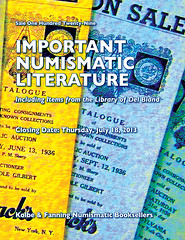 Kolbe & Fanning Numismatic Booksellers wish to remind their customers that their 129th mail-bid sale of important numismatic books closes this Thursday, July 18. The sale features selections from the library of renowned U.S. copper specialist Del Bland and other properties, and includes works on ancient, medieval, foreign and U.S. numismatics.
Kolbe & Fanning Numismatic Booksellers wish to remind their customers that their 129th mail-bid sale of important numismatic books closes this Thursday, July 18. The sale features selections from the library of renowned U.S. copper specialist Del Bland and other properties, and includes works on ancient, medieval, foreign and U.S. numismatics.
Among the 660 lots, which cover the entire range of numismatics, some highlights include:
—The complete Erbstein collection, bound with the rare 1911 Hess sale of Hermitage duplicates (lot 83)
—A complete set of Barney Bluestone catalogues (lot 253)
—The first numismatic article published in the U.S. on American coins (lot 483)
—Del Bland’s remarkably fine complete set of Stack’s catalogues (lot 556)
—A rare plated Chapman catalogue of the Simpson collection (lot 354), among many other plated Chapman catalogues including Earle, Jenks, Gable, Sargent and others.
—Mayer’s rare bibliography of Islamic numismatics (lot 132)
—Walker’s classic work on Arab-Byzantine and Umayyad coins (lot 219)
—The first plated U.S. numismatic auction catalogue (lot 363)
—Charles Elmore Green’s Deluxe, Photographically Illustrated Dunham Catalogue (lot 488)
—The Jack Collins research files on Peter Getz (lot 374).
Bids may be placed via mail, email, phone or fax. Phone bids will be accepted until 6 pm on Thursday, July 18 at (614) 414-0855. Voicemail, fax and email bids will be accepted until midnight. Faxes should be sent to (614) 414-0860; emails should be sent to df@numislit.com.
The catalogue may be downloaded in PDF form from the Kolbe & Fanning website at www.numislit.com. For full bidding instructions, please see the catalogue and read the terms of sale.
Thank you, and we look forward to your participation!
NEW BOOK: COMMUNION TOKENS
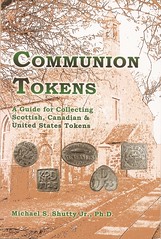 Communion Tokens: A Guide for Collecting Scottish, Canadian & United States Tokens.
Communion Tokens: A Guide for Collecting Scottish, Canadian & United States Tokens.
Author: Michael S. Shutty, Jr.
ISBN-13: 978-1-60047-878-9
Format: 6 x 9 Trade Paperback
Pages: 137
Price: $14.95
If you are interested in Communion Tokens, you are not alone. However, it sure seemed that way when I started collecting them a few years ago. I found that most of the references are decades old except for the encyclopedic listing of communion tokens published by Lester Burzinski in 1999. Unfortunately, his tome is hard to come by, as only 250 copies were printed. Furthermore, there were no introductory guidebooks that provided an overview of the series to help collectors get started. Consequently, I decided to take on this challenge. The result is this book and a blog that I started on blogspot.
 Communion tokens come in all sizes and shapes. There are over 7000 of them worldwide, but most come from Scotland where the Presbyterian Church became the established church of the land. Canadian tokens are also popular, whereas the American tokens are rarely encountered. Most collectors gravitate towards the Scottish pieces, as the variety is entertaining. Communion tokens are old too; they are available from the mid-seventeenth century onward. Personally, I find the old ones inescapably charming, as many of them are molded from handcrafted dies.
Communion tokens come in all sizes and shapes. There are over 7000 of them worldwide, but most come from Scotland where the Presbyterian Church became the established church of the land. Canadian tokens are also popular, whereas the American tokens are rarely encountered. Most collectors gravitate towards the Scottish pieces, as the variety is entertaining. Communion tokens are old too; they are available from the mid-seventeenth century onward. Personally, I find the old ones inescapably charming, as many of them are molded from handcrafted dies.
The tokens were part of the Presbyterian fabric until the first quarter of the twentieth century. They were passed out to selected parishioners prior to the communion service to allow admittance to the Lord’s Table. The minister, assisted by the church elders, examined all those requesting tokens to insure their probity.
 As such, it was an honor to receive a token and a disgrace to be refused one. There are interesting stories about how some folks bartered to gain a token, and how others were called out by ever vigilant neighbors as they approached the table, only to have their token taken away for being a witch, thief or fornicator. Certainly, these were interesting times.
As such, it was an honor to receive a token and a disgrace to be refused one. There are interesting stories about how some folks bartered to gain a token, and how others were called out by ever vigilant neighbors as they approached the table, only to have their token taken away for being a witch, thief or fornicator. Certainly, these were interesting times.
Communion Tokens: A Guide to Collecting Scottish, Canadian & United States Tokens is available on the Wasteland Press website: Books123.org. For more information about the book or the tokens, check out the blog at communiontokens.blogspot.com .
NEW BOOK: CURRENCY LEGISLATIONS OF THE EAST INDIA COMPANY, 1772-1835
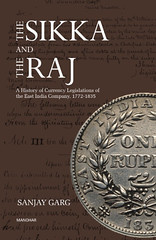 Title : The Sikka and the Raj: A History of Currency Legislations
of the East India Company, 1772-1835.
Title : The Sikka and the Raj: A History of Currency Legislations
of the East India Company, 1772-1835.
Author : Sanjay Garg
ISBN : 9788173049705
List Price : Rs 1,495.00
First Published : 2013
Pages : 544
Edition : Hardbound
In the process of colonization of India by the British, currency proved to be a vital weapon as it directly affected almost every aspect of the economic life of the society. The book encapsulates the story of Indian currency during the early days of the colonial rule in India. It presents a comprehensive account of the currency policy of the British East India Company, which it pursued to establish a uniform currency in India.
The process of currency legislations enacted by the Company, the circumstances leading to the adoption of these legislations, as well as the effects of these legislations on the prevailing economic conditions in the country, have been analyzed with a view to establish a relationship between the stability of the currency vis-à-vis the economic colonization of India by the East India Company.
By integrating numismatic data with the archival sources, the book scrutinizes various internal and external forces which were at work in shaping the monetary structure during early days of the colonial rule in India, and presents a new insight about the role of currency in the colonization process of India.
The objective of this study is not merely to have a ‘cause and effect’ understanding of the currency reforms carried out by the East India Company, but also to delve into the often-overlooked or neglected prognosis of the ‘what and how’ of its process.
All related archival material – a series of 39 Regulations (1793-1833) and two Acts (1835) – has been incorporated in the appendices which makes this book a veritable tool for reference and further research.
DR. SANJAY GARG is a numismatist of international repute. He obtained his Ph.D. in History from the Jawaharlal Nehru University and Diploma in Archival Studies from the National Archives of India, New Delhi.
Author of several books and research papers, Dr. Garg was also a recipient of the Charles Wallace Fellowship at the University of Cambridge, Fitzwilliam Museum, U.K. (1998); Resident Fellowship at Centro Incontri Umani (Socio-Cultural Centre), Ascona, Switzerland (2009); Robinson Visiting Scholarship at the Ashmolean Museum of Art and Archaeology, University of Oxford, together with the Kraay Visitorship at the Wolfson College, University of Oxford, UK (2010).
Dr. Garg has served at the National Archives of India for 24 years and is at present heading the Research Division of the SAARC Cultural Centre, Colombo. He is also the Executive Editor of the SAARC Culture and Editor of the Numismatic Digest.
Purchase the book, see: The Sikka and the Raj: A History of Currency Legislations of the East India Company, 1772-1835. (www.manoharbooks.com/BookDetails.asp?bookid=126970)
NEW BOOK: AMERICAN SILVER EAGLES, 2ND EDITION
 Whitman Publishing announces the release of the updated, revised second edition of American Silver Eagles: A Guide to the U.S. Bullion Coin Program, by John M. Mercanti and Michael “Miles” Standish. The 176-page hardcover book is available online (including at www.Whitman.com) and from book stores and hobby shops nationwide. It retails for $29.95.
Whitman Publishing announces the release of the updated, revised second edition of American Silver Eagles: A Guide to the U.S. Bullion Coin Program, by John M. Mercanti and Michael “Miles” Standish. The 176-page hardcover book is available online (including at www.Whitman.com) and from book stores and hobby shops nationwide. It retails for $29.95.
“If any numismatic book has earned the title of ‘runaway best-seller,’ it’s American Silver Eagles,” said Whitman publisher Dennis Tucker. “The first edition sold out in a few months, with tens of thousands of copies eagerly snapped up by enthusiastic coin collectors and investors.” Authors John Mercanti and Miles Standish promoted the book in late 2012 and early 2013 through social media and appearances including at the Whitman Coin & Collectibles Expo in Baltimore.
American Silver Eagles quickly earned praise from the hobby community, with reviewers calling it “invaluable,” “impressive,” and “a book that belongs in your library” (1) . . . “a real pleasure to read, especially because of the lavish illustrations and the coffee-table format” (2) . . . “beautiful” and “vitally informative” (3) . . . “three books in one” (4) . . . “an outstanding reference” and “a great value” (5) . . . and a “comprehensive guide to [the] silver bullion coin” with “possibly everything you ever wanted to know about the silver American Eagle.” (6)
In the second edition, the story of the American Silver Eagle is expanded to include new information on the U.S. Mint’s individual coins and sets of 2012 and 2013. Additional research and more photographs expand the coverage of earlier issues, as well. More historical photographs have been added to chapter 2 (Mercanti’s behind-the-scenes history of the American Silver Eagle). Certified coin populations are updated, as are the valuations seen in today’s sometimes volatile marketplace. Additional images and information bring the book up to date in chapter 4 (covering the Mint’s other silver, gold, and platinum issues, plus the Treasury’s report on palladium coins). And a new appendix explores the phenomenon of surface spotting on American Silver Eagles.
These additions and updates, building on the solid foundation of the first edition, make American Silver Eagles, second edition, an equally valuable reference for every collector’s and investor’s library.
For more information, or to order, see: American Silver Eagle - A Guide to the U.S Bullion Program - Expanded 2nd Edition (www.whitman.com/store/Inventory/Detail/American-Silver-Eagle---A-Guide-to-the-U-S-Bullion-Program---Expanded-2nd-Edition+0794840302)
BOOK REVIEW: OXFORD HANDBOOK OF GREEK AND ROMAN COINAGE
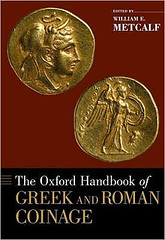 21st Century Numismatics: The Oxford Handbook of Greek and Roman Coinage
21st Century Numismatics: The Oxford Handbook of Greek and Roman Coinage
Edited by William E. Metcalf
Oxford University Press, 2012
Review written by Roger Kuntz
This book represents an unprecedented innovation in numismatic literature and is becoming widely regarded as the best introduction to classical ancient coins. It is far more than a guide written solely for collectors. Instead, it was written to serve also as an introduction for graduate or post-doctoral students in the ancient cultures who seek training in classical numismatics. As a work in the renowned Oxford Handbooks series, this volume was written to offer an authoritative and annotated state-of-the-art survey of current thinking and research in the subject area. However, it is just that focus that makes it such a valuable text for serious collectors of ancient coins.
The book contains a collection of 33 essays, covering all aspects of Greek and Roman numismatics. Each chapter has been contributed by the authority having pre-eminent expertise in the topic under consideration. The presumption by all 33 of the contributors has been that readers would have no previous knowledge of any aspect of numismatics, thus keeping this volume accessible to readers at all levels.
It begins with a general introduction by the editor, William E. Metcalf. His article considers the role of scientific analysis in our discipline, explaining how numismatic research is done in the 21st-century. After that introduction, the following 32 chapters, each written in an easy prose-style, constitute an account of the history and evolution of ancient coinage. Each essay provides a systematic overview of the topic as well as a critical account of the progress of numismatic study, illustrating throughout the book how modern techniques such as die studies, hoard analysis, and mint-output data have advanced our knowledge of ancient numismatics.
This survey rightly begins with the electrum coins of Lydia. This innovation was followed some 80 years later by the introduction of a bi-metallic (silver and gold) monetary system. A prolific silver coinage was introduced at Athens with-in a generation, and it soon inundated the economies of the Aegean and the Near East. The type, featuring Athena and her owl, was struck over four centuries, becoming the first coinage accepted throughout the known world.
This was followed by a bewildering array of types struck to a plethora of standards that are well-described here. The typological diversity of these and the Roman Republican issues is well-illustrated. During Caesar’s monarchy, he was allowed the privilege of placing his portrait on his coins, thus resulting in the development of portraiture as the most powerful instrument of numismatic propaganda – an iconographic development that has persisted until modern times. The evolution of imperial titles under succeeding emperors is examined in detail. The development of reverse types in great variety stressed imperial achievements and the current events of their day. The interplay between metropolitan and provincial issues is ably illustrated.
By the beginning of the 3rd-century, monetary pluralism prevailed. While Roman coinage may appear to the casual observer to adhere over time to tradition, it was actually in a constant state of change. Each short-lived dynasty made significant alterations according to its own familial needs.
The use of female portraits as obverse types is explained in terms of dynastic propaganda. The reasons for the issuance of commemorative coins and the types proclaiming religious beliefs are discussed. Finally, the appearance of idiosyncratic types and unusual minting practices that made the later Roman coins so complicated is explained. The overall impression is one of stability during the first century followed by gradual decline in the later centuries.
The currency system established by Augustus collapsed during the third century and was replaced by a “Late-Roman” system based on the use of smaller base metal coins. The iconographic tradition of realistic portraiture inherited from the Greeks gave way to the use of idealized portraits in the decades before the introduction of Byzantine types.
William E. Metcalf is a former curator at the American Numismatic Society and currently serves as an Adjunct Professor of Classics at Yale University and the Ben Lee Damsky Curator of Coins and Medals at the Yale Art Gallery. This volume contains 900 digital photographs of ancient coins that have been placed at the appropriate points within each essay. Each chapter is also accompanied by its own very extensive bibliography. This book is now being acclaimed as the most informative single-volume work on ancient coinage that has been published to date. As such, it belongs in the library of every collector who has a broad interest in all facets of numismatics.
For more information, or to order, see: The Oxford Handbook of Greek and Roman Coinage (global.oup.com/academic/product/the-oxford-handbook-of-greek-and-roman-coinage-9780195305746?cc=us&lang=en&)
For more information about the Rochester Numismatic Association, see: www.the-rna.com
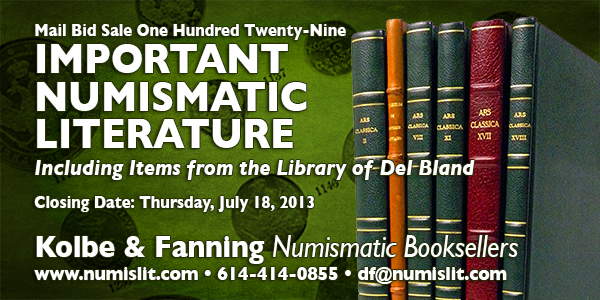
THE IMPORTANCE OF NUMISMATIC BIBLIOGRAPHIES
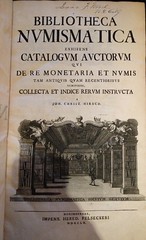 Among the Library’s most recent acquisitions is George Kolbe’s new publication, The Reference Library of a Numismatic Bookseller, which was privately printed and limited to 150 copies. Although the topic may initially seem very narrow and focused, the book is an important reference tool for numismatic researchers and reminds us of the general importance and abundance of numismatic bibliographies. Bibliographies in general are particularly important to libraries as a way of identifying relevant works and assisting researchers. Well organized bibliographies, like Kolbe’s, can be particularly useful in guiding research.
Among the Library’s most recent acquisitions is George Kolbe’s new publication, The Reference Library of a Numismatic Bookseller, which was privately printed and limited to 150 copies. Although the topic may initially seem very narrow and focused, the book is an important reference tool for numismatic researchers and reminds us of the general importance and abundance of numismatic bibliographies. Bibliographies in general are particularly important to libraries as a way of identifying relevant works and assisting researchers. Well organized bibliographies, like Kolbe’s, can be particularly useful in guiding research.
The ANS Library reference section contains more than 700 books, many of which are bibliographies, which can be as broad as Dekesel’s mammoth works (Bibliotheca Nummaria series) that aim to include all numismatic literature published by century, starting with the 16th century, to as narrow a bibliography as that of a single author, such as Carl H. Schaible’s 1952 Bibliografia de José Toribio Medina. Even the ANS Library’s online catalog, DONUM, serves as its own electronically published numismatic bibliography, containing more than 180,000 records of items in the collections, with each record containing not only location information, but essential bibliographic information that can assist any researcher.
Numismatic bibliographies have been compiled for centuries although interest really increases after the appearance of the earliest works of numismatic literature by Guillaume Bude and Andrea Fulvio in the early 16th century. The earliest book to contain a numismatic bibliography appeared in 1579, written by Antoine Le Pois. The introductory pages of his book, Discours sur les medalles et graveurs antiques, principalement romaines, include about 5 pages of bibliographic discussion that mentions other 16th century authors such as Fulvio, Erizzo, and Goltzius, among others, as part of his larger scholarly study on Roman coins and antiquities.
But the earliest official numismatic bibliography (as a work of its own) can be traced back to Philippe Labbé (1607-1667), a Jesuit priest, who published his Bibliotheca Bibliothecarum in 1664 in Paris. Labbé’s bibliography adopted an alphabetical arrangement by first name of the author and appeared in several editions between 1672 and 1695. This was notably followed by Burckard Gotthelf Struve’s Bibliotheca numismatum antiquiorum (1693), Anselmo Banduri’s Bibliotheca nummaria (1718), Franz Ernest Brückmann’s Bibliotheca numismatica (1729), and Johann Christoph Hirsch Bibliotheca numismatica (1760), which lists more than 1500 works arranged alphabetically by author or title and includes a beautiful frontispiece depicting a numismatic library
DAVE BOWERS' FINAL WORD ON JOHN J. FORD
Dave Bowers writes:
Regarding the Clifford Collection, this catalog was in essence written by John Ford via all of the information he provided to our California office. By that time I had been living in New Hampshire for two years and was not involved in this or most other sales.
When people read (past tense) stuff in catalogs and find something to be a point of discussion, I usually hear about it. Of course, 1982 was ancient history—before the Internet—so queries often came with a postage stamp attached. I don’t recall anyone commenting on the Clifford coins one way or the other.
Going back a few years I wrote an extensive recollection of JJF which I shared with Karl Moulton a couple years ago. As I mentioned in my latest (and last) Coin World column on the subject, Karl revealed the JJF I didn’t know.
In my July 15 column, I discussed John J. Ford Jr. and his discoveries of hitherto unknown varieties of Western gold coins and ingots. John was viewed as America’s leading authority on counterfeits, alterations and forgeries, and was recognized as such by the American Numismatic Association, the Professional Numismatists Guild, and by many collectors and dealers.
Coming to the rescue of John was Dr. Donald Kagin, whose book, Private Gold Coins and Patterns of the United States, was published in 1981.
Many if not most of John’s new discoveries were included in the book. John said that Kagin had done extensive research, had unimpeachable credentials on the subject of Western numismatic Americana, and had independently verified the coins and ingots, thus settling the matter once and for all.
John made a special arrangement for my company to receive and offer for sale discounted copies of the book. He wanted it to be as widely distributed as possible. Finally, his name had been cleared by a third party.
However, upon study, for me many of the illustrations raised further questions. Pictured were items made by the U.S. Assay Office of Gold in San Francisco that were marked as .999 pure (999/1000ths).
How could that be, I wondered, when at the time, the assay office had problems refining gold to even .900 pure, the federal standard?
Some years ago, I began writing reminiscences of Ford as part of some autobiographical notes.
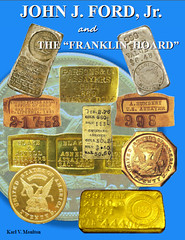 Karl Moulton, a researcher who became interested in the controversy, learned of this and wrote to me stating that he had acquired copies of many of John’s papers from the disposal of his estate, had done other studies, and was going to write a book.
Karl Moulton, a researcher who became interested in the controversy, learned of this and wrote to me stating that he had acquired copies of many of John’s papers from the disposal of his estate, had done other studies, and was going to write a book.
He asked me to be a copy editor, and I agreed. Others contributed as well.
Now in print, John J. Ford, Jr., and the “Franklin Hoard” — containing extensive Ford correspondence, invoices and other material — reveals that Ford created many fabrications — saying one thing about the pedigree or origin of a newly discovered item to one buyer and something different to another buyer.
The John J. Ford Jr. delineated by Karl Moulton is not the John that I thought I knew.
I still like to think that John was very good to me over a long period of time. He helped me with much research in Colonials, early American coins, tokens and other specialties. And, without question, his New Netherlands catalogs were and are magnificent. Let me suggest that he was 90 percent good for the hobby and 10 percent negative and self-destructive.
The Moulton book is more than 900 pages in length, color illustrated, hardcover and on fine paper. It is available if you send $250 to Karl Moulton, P.O. Box 1073, Congress, AZ 85332.
To read the complete article, see: John J. Ford Jr. fabrications (www.coinworld.com/articles/viewarticle/2807)
To read an earlier E-Sylum article, see: BOOK REVIEW: JOHN J. FORD AND THE FRANKLIN HOARD (www.coinbooks.org/esylum_v16n28a06.html)
VIDEO: DAVID FANNING ON NUMISMATIC LIBRARIES
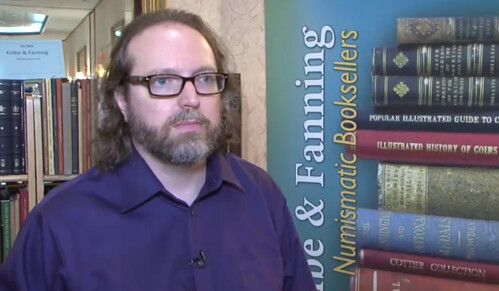
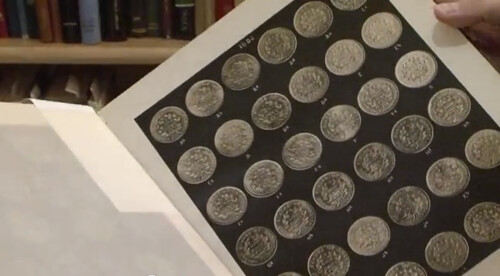
To view the video, see: David Fanning Talks About the Importance of a Numismatic Library (https://www.youtube.com/watch?v=yzwsIJacNE4)
THE BOOK BAZARRE
MORE ON THE 1864 STONEWALL JACKSON MEDAL

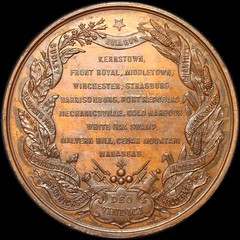
Harold Levi writes:
The article on the Stonewall Jackson medal contains a number of errors. In the process of my research I copied all four of the original September, October, November and December 1894 advertisements from original Confederate Veteran magazines. The copies were made at Elm Springs, Columbia, Tennessee, the World Headquarters for the Sons of Confederate Veterans, of which I am a member. I have attached the November 1894 advertisement.
The article mentions that the medals were found when a building was being razed. However, many of the medals show fire damage. It seems to be unknown if the building was razed because of a fire or the building was razed with fire.
This episode illustrates what we modern-day Confederates do. We try to make sure the story is accurate even if it makes the Confederates look bad. Northerners often complain that we Southerners keep fighting the War. All we want is that the story be told accurately - - as is possible.
Peter Bertram writes:
The article reprinted in the last E-Sylum unfortunately perpetuates several popular misconceptions concerning the Stonewall Jackson medal. For example:
- "A privately commissioned medal ......." : Funds for the medal were raised in Richmond by public subscription in late 1863, invested in cotton and sent to Europe.
- ......"heroic bust of Jackson "......: The likeness of Jackson was terrible - it looked more like Lincoln (Jackson's widow called it “miserable”) and selling them was a tough go because of it.
- ...."is a Latin inscription meaning "Claimed by God". : "Deo Vindice" has traditionally been interpreted as "God Our Vindicator" and close similar sentiments.
- "Lamar commissioned Armand Caque to design and have the Stonewall medal struck". See above - plus, as a staunch Confederate, Lamar would never have accepted the errors in the battle listings on the reverse, such as referring to the Battle of First Manassas as BULL RUN or to Sharpsburg as ANTIETAM. - and some five or six other errors.
- "Before seeing the medal, of which perhaps 500 were struck, Charles Lamar was killed in action…… ". Horse feathers! The first time Lamar was even aware of the medals was when he saw them at an exhibition in Paris in 1863. As to his death, he was killed April 16, 1865 near Columbus, Georgia while serving as Aide-de-Camp to General Howell Cobb.
- Not mentioned is that there were two shipments of the medals. One ended up in Richmond just before the city fell and are quite possibly the medals that showed up in the early post-war numismatic trade. The other, larger, shipment was the one that ended up in Savannah.
Thanks, everyone. We'll eagerly await further information on the progress of Peter's book. It's great to have researchers doing the legwork to flesh out the stories and correct earlier misinformation. -Editor
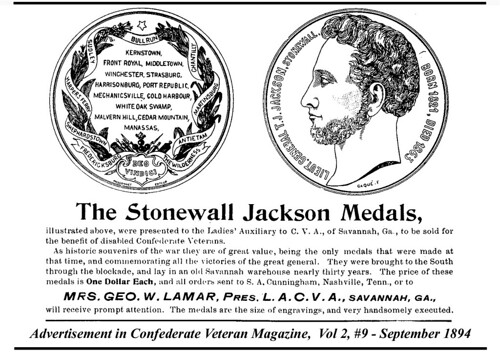
To read the earlier E-Sylum article, see: THE 1864 STONEWALL JACKSON MEDAL (www.coinbooks.org/esylum_v16n28a25.html)
ERIC P. NEWMAN'S M. L. BEISTLE HALF DOLLARS
I've been attributing Eric P. Newman coins since getting back from the ANA Seminar, and there are countless amazing specimens. Most of these are ex: "Colonel" E. H. R. Green and are so noted on the labels, which are themselves special printings for the Newman Collection. I'm doing variety attributions, not the provenances. Those are already established.
I'm particularly taken with the early half dollars, as these are nearly all Green coins and thus also ex: M. L. Beistle, author of the first variety book devoted to half dollars. Beistle sold his half dollar reference collection to Green en bloc during the summer of 1928, and this transaction is documented in my forthcoming book on The National Coin Album and related products.
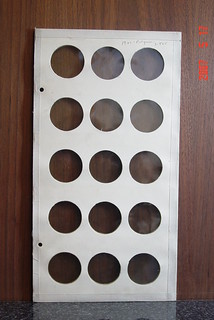 Of course, the National Album was originally created by Beistle in 1927 as the Unique Coin Holder, and he housed his own collection in these pages for easy comparison while writing his reference book. The coins were acquired by Green still mounted inside Unique Coin Holders, hundreds of which he had already purchased from Beistle earlier that year for his other coins. I've reproduced much of this correspondence in my book, yet more remains within The Beistle Company Archive for the interested researcher.
Of course, the National Album was originally created by Beistle in 1927 as the Unique Coin Holder, and he housed his own collection in these pages for easy comparison while writing his reference book. The coins were acquired by Green still mounted inside Unique Coin Holders, hundreds of which he had already purchased from Beistle earlier that year for his other coins. I've reproduced much of this correspondence in my book, yet more remains within The Beistle Company Archive for the interested researcher.
Bidders who are successful in acquiring ex: Green halves during November's auction in NYC should keep in mind that they are also possessors of coins that may be traced directly to M. L. Beistle, author and inventor of the first coin album product.
NOTES FROM E-SYLUM READERS: JULY 14, 2013
Didier Vanoverbeek Located
Last week, Roberto Jovel asked about an article by Didier Vanoverbeek on the 1904 issue of El Salvador Pesos or Colones at the Hamburg Mint. Gar Travis located an email address for Vanoverbeek. Roberto writes:
I already obtained the same reference very recently, and contacted Mr. Vanoverbeek, who is kindly assisting in obtaining the information I need. Let me express my appreciation for the great tool that The E-Sylum is!
To read the earlier E-Sylum article, see: NOTES FROM E-SYLUM READERS: JULY 7, 2013: Query: Article on 1904 El Salvador Pesos Sought (www.coinbooks.org/esylum_v16n28a11.html)
Island of Stone Money License Plate
Regarding Yap Stone money, Tom Sheehan forwarded the following images.

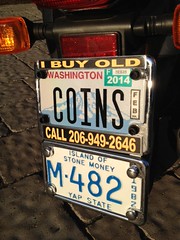
Tom writes:
The scooter is mine. I use it to putz around town and park it in front of my office where I sometimes meet people to buy or evaluate collections. It gets me 78 miles a gallon.
Since I have one piece of Yap Stone Money I thought it appropriate to have the Yap motorcycle license plate too.
To read the earlier E-Sylum article, see: DAVID O'KEEFE AND YAP STONE MONEY (www.coinbooks.org/esylum_v16n28a21.html)
Rich Hartzog On Token And Medal Books Yet To Be Published
Rich Hartzog writes:
I do take minor issue with Dick Johnson on his list of Token/Medal subjects NOT having books. There are in fact books on:
- Calendars - Two volume set Tempus in Numis by Sweeny/Turfboer
- Dog License Tags - By Bill Bone on Pre-1900 Tags
- Encased Coins - Oregon by Jim Hemphill, I think others exist.
- Movie Money - I can't recall the title, but issued.
- Wooden Money - several issued, years ago, by DiBella and Hudson, and Arizona Wood by Dow, and one on NY Wooden Money by Boughton
One of the problems with token/medal books is that the author/publishers often issue so few books, that the titles go out of print rapidly. Bill Bone has issued two editions of his book. But, I don't have the book on Movie Money, although I want to say it was done by Fred Reed. Another problem is that books would have to be so huge to be unaffordable. For example, I have over 1000 Illinois Encased coins in my collection, so any book on Encased would be massive (Even a 300 average per state would mean 15,000 listings).
As Peter Irion (not "Iron" as listed occasionally) says, which books make financial sense? If there is no collector base, it is hard to justify printing hundreds of copies. Perhaps now with POD (Print on Demand) books, more authors will be able to publish. How many people will buy a book listing the 7000 medals of Medallic Art? It will be giant, and expensive. A print run of 300 might be too many.
For example TAMS published Medals of the United States Mint, the First Century 1792-1892 and did a fantastic job of printing it. However, they spent so much on it, they couldn't make any money! They printed 3000 copies, sold 700, gave up, and sold some 2300 copies to me, losing about $42000 on the ones I bought. Published in 1977, it has taken me until now to sell the 2300 copies.
It's a wonderful book, and I have considered another supplement beyond my two Price Guides. But even this great book is not a hot seller. Not too many people want to print a 35 year supply of any book! Given the amount of work involved in producing a Second Century book, would the demand be enough to sufficiently reward the publisher? My two cents.
Ron Ward adds:
You asked about US Mint Medals issued after Julian. The only publication is "Medals of the United States Mint Issued for Public Sale", Department of the Treasury, Revised 1972, Library of Congress Catalog No. 74-602460, 312 pages. Several copies are still available on Abebooks and Amazon. No later editions were published.
On page 312 are listed miniature presidential medals, through President Nixon, 1 5/1 inch diameter. These were from the Philadelphia mint (no mint mark) or Denver with a "D". These were available in bronze or gold plated. The latter were also available with a plated loop attached to the top rim so it could be placed on a chain or bracelet. I imagine that it would be impossible to find a set of all these medals today except for the bronze medals.
In 1972, the highest price for a large mint medal (Hayes, Indian Peace - 3 X 2 3/8") was $8.00 Over-the-Counter and $8.25 by Mail Order.
To read the earlier E-Sylum article, see: DICK JOHNSON ON TOKEN AND MEDAL BOOKS YET TO BE PUBLISHED (www.coinbooks.org/esylum_v16n28a20.html)
Ferracute Chinese Cash Coin Identified
Ken Spindler writes:
The image of the machine-struck brass cash (denomination) coin in the article on the Ferracute Machine Company is upside-down. The mint name on it is Boo yuwan (left-right, once oriented (no pun intended) correctly), for The Board of Works, in Beijing. Subject to verifying the other side of the coin, it is almost certainly the pattern KM-Pn. 2, in earlier editions of Krause-Mishler at least, also catalogued as Hsu-3, attributed to New Jersey manufacture in 1897. That fits the story to a "T."
Thanks. Here's the corrected image.
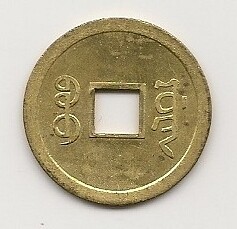
To read the earlier E-Sylum article, see: THE FERRACUTE MACHINE COMPANY (www.coinbooks.org/esylum_v16n28a26.html)
More on Modern Spanish Coin Dating
Ken Spindler writes:
Perhaps the data about the range of years that "modern peseta" coins of Spain have been double dated to include the actual year of minting contained within a very small star or 2 stars are accurate, but the practice of noting (some) true years of mintage of coins of Spain within such stars dates back to 1868. So, the century on such coins can be "18," too.
Not only peseta denominations have been involved, but many coins of almost all denominations struck since 1868, small coppers to gold, show true dates in stars. The practice was not entirely consistent for all coins, however. I often point this fun factoid out to children (and parents) who visit our "Coins-for-Kids" give-aways of foreign coins at local coin shows and the annual County Fair here in San Diego, if I can locate a coin of Spain in the pile of donations from local collectors. Not surprisingly, a magnifier is a must for this study.
To read the earlier E-Sylum article, see: FEATURED WEB PAGE: DATES ON MODERN SPANISH PESETA COINS (www.coinbooks.org/esylum_v16n28a35.html)
The Two-Masted Ketch
Yossi Dotan writes:
Regarding the article profiling Canadian coin designer John Horton, here is an image of the reverse of the tall ship coin he designed, The Ketch (not "the catch"!), KM#667, 20 dollars 2006. (The obverse depicts Queen Elizabeth II.)
The reverse depicts a ketch at sea shown against a hologram-enhanced sky with rolling storm clouds and lightning flashes. The two-masted ketch is rounding Cape Diamond in southern Quebec. The sailors depicted are preparing the ship for the storm. The ketch hails from the early 19th century. Today it is a popular recreational yacht.

To read the earlier E-Sylum article, see: ARTICLE PROFILES CANADIAN COIN DESIGNER JOHN HORTON (www.coinbooks.org/esylum_v16n28a29.html)
2012 Finland 5 Euros Wildman Catalog Number
Regarding Bob Knepper's question about the Finland "Wildman" coin, Pabitra Saha writes:
Although I do not yet have 2014 copy of SCWC, but this info can be seen at numismaster.com. As of now, no KM # has been allotted to this coin.
To read the earlier E-Sylum article, see: QUERY: CATALOG NUMBER FOR 2012 WILDMAN COIN SOUGHT (www.coinbooks.org/esylum_v16n28a13.html)
More on the Erlanger Jungle Inn Token
Regarding Harold Levi's Kentucky token, Jerry Schaeper Jr. writes:
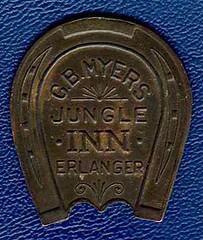 This JUNGLE INN token is surely from Erlanger, KY. Not a common piece at all.
I don't have a street address for it, but will try to locate something. Many of the
Erlanger saloons were on Dixie Highway, a major Rt. 25 that went through
Lexington and points South.
This JUNGLE INN token is surely from Erlanger, KY. Not a common piece at all.
I don't have a street address for it, but will try to locate something. Many of the
Erlanger saloons were on Dixie Highway, a major Rt. 25 that went through
Lexington and points South.
I live right on the Edgewood/Erlanger border. My town is Edgewood but have an Erlanger Zip Code (41018). The horse shoe, barrel, horse head, etc shaped tokens are very prevalent shapes for tavern tokens from my area. There are even chickens, a fish (from Covington), a boxing glove (from Erlanger), and a host of other odd shapes.
To read the earlier E-Sylum article, see: QUERY: KENTUCKY HORSESHOE TOKEN INFORMATION SOUGHT (www.coinbooks.org/esylum_v16n28a18.html)
MORE MEMORIES OF J.V. MCDERMOTT
Barry Stallard writes:
I grew up in Northern Illinois in the town of Freeport. Like Dave Hirt, I also delivered the local newspaper and I looked for scarce dates needed for my small coin collection by searching the weekly payments (35 cents) I received from my customers for paper delivery. I belonged to the local coin club during my middle school years in the early 1950’s. My dad would occasionally drive me to attend monthly meetings of other clubs in the area.
It was at one meeting, I think in Dixon, Illinois, that J.V. McDermott appeared and showed off his nickel encased in a plastic holder. He passed it around the room for everyone to examine. I wondered that he so casually did this since it was so valuable. But he said that he didn’t worry about getting it back because it was so well known that he was the owner.
Tom Casper writes:
I never met J.V. McDermott so I can't share any recollections of him. I was told of him and his famous nickel when I joined the Milwaukee Numismatic Society in 1967. He had also been a member of the MNS. A check of early MNS rosters from 1961-1963 showed he was member #104.
I did find one article about him in my files. It pictures him and his nickel. This article was published after he passed away on 9-29-66.
There are recollections of McDermott in the book, "Million Dollar Nickels-Mysteries of the Illicit 1913 Liberty Head Nickels Revealed" by Paul Montgomery, Mark Borchardt and Ray Knight. Check Chapter 7, pages 173-176.
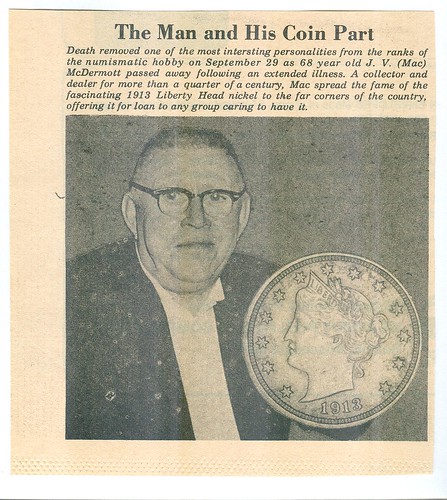
John Dirnbauer writes:
Dave Hirt's comments about J.V. McDermott brought back some memories.
After WWII, my father, Martin J. Dirnbauer, managed the operation of the Zenith Lanes on Kilbourn Avenue in Milwaukee, WI. The Dirnbauer family businesses in the 1930-1950's were quite diversified. The Zenith was a "Laverne and Shirley" type of bowling alley with eight lanes in the basement of a building with a pizza parlor just above on the street level.
This bit of family history is pertinent due to the fact that the local coin collectors regularly gathered in the bar at the Zenith to discuss coins, share stories, play table shuffleboard and cup dice and drink martinis.
The Star Rare Coin Encyclopedia and the advertising of B. Max Mehl were the fuel of conversation. J.V. McDermott was a regular at the Zenith and would freely show his 1913 Liberty Head nickel. I was five or six years old at the time (1952-53)and more interested in bowling duck pins than looking at silly old coins. However, I was reminded on a few occasions that Mr. McDermott put me on his knee, put that rare coin in my hand, and admonished me to remember it. I was thrilled to see that coin and its four siblings at the Baltimore ANA in 2003.
To read the earlier E-Sylum article, see: J. V. MCDERMOTT AND HIS 1913 LIBERTY HEAD NICKEL (www.coinbooks.org/esylum_v16n28a15.html)
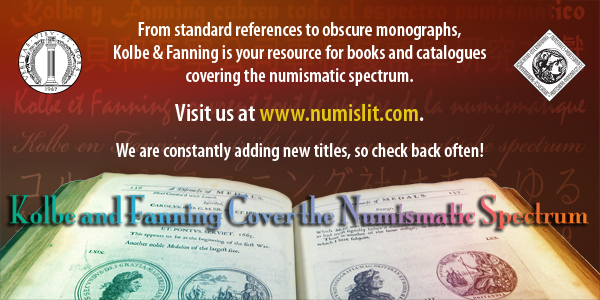
THE “DR L. ROPER.” COUNTERMARK ENIGMA
“How many coins are known with a pedigree to Lewis Roper?” That was the e-mailed question I received on the evening of May 13, 2012. I immediately thought, “I wish there was even one.”
Dr. Lewis Roper (ca.1805-1850) was a pioneering numismatist whose coin collection—back in 1851—was the first in the United States to be sold at public auction. A total of 2,383 coins and medals crossed the block during that two-day sale, but those were early days in the U.S. coin hobby. Few of the collectors who so eagerly purchased Dr. Roper’s coins recorded the source, and mid-19th century coin dealers tended to omit provenance information from their catalog descriptions, so the Roper pedigrees were soon lost. Therefore, my response was succinct: “None.” However, It was a safe bet that my correspondent, John J. Kraljevich Jr. had some additional knowledge up his sleeve, so I invited him to tell me more!”
John has a remarkable knack for locating distinctive and significant coins, medals and notes from the colonial and early national periods of our nation’s history. But to think that he had found a coin actually pedigreed to Dr. Lewis Roper! Even for John, that would be a very tall order, akin to an astronomer finding cosmic material that could be traced directly back to the “Big Bang.”
Amazingly enough, John had done just that. He shot back a message with the subject line: “Sometimes a piece has a collector’s name written all over it…” The photo attached depicted the obverse of a 1791 Washington large eagle cent. Sure enough, between the data and the truncation of Washington’s bust, there was a neat countermark reading “Dr L. Roper.” As I stared at the screen, it occurred to me that, after 161 years, one of Lewis Roper’s coins had finally been found!
John then brought me back to earth with a few thoughtful observations. “The host coin,” he wrote, “is certainly genuine, and the countermark looks as if it was made in the first half of the 19th century. There is every indication that this was one of Dr. Roper’s coins.” But then, John threw down the “coin geek” gauntlet: “Of course,” he said, “’highly probable’ is not the same thing as ‘proof.’ After all, I bought the coin, via e-Bay, from a person in Traverse City, Michigan. Can someone prove that this was Dr. Roper’s coin?”
It was a challenge that I had to accept, and the quest for evidence took me down research pathways that led to surprising numismatic discoveries, but—did I find the “smoking gun”—did I prove that this countermarked Washington cent had once belonged to the celebrated Dr. Lewis Roper?
I wondered how John managed to find the coin, and where it currently resided. Joel wrote:
I've been getting a lot of nice feedback from various folks. It would have been even cooler if I had been able to prove that the coin was Dr. Roper's, but getting close to proving it was a lot of fun!
I can confirm its current whereabouts--I left it deliberately vague in the article, but it currently resides in my safety deposit box.
I wish I knew how John does it. He finds more rare, historical, and significant pieces in a month than most dealers find in a lifetime. My only viable theory is that a side deal with Lucifer may be involved!
I responded:
My money is on a Time Machine. I got out my magnifier and looked over some old Chapman auction room photos. There’s a thin guy with dark hair and a handlebar mustache that looks awfully familiar…
Joel responded:
The other possibility is that John is one of the Chapman Brothers--I'd favor Henry due to the luxuriant beard-growing capacity--who has found a way to Methuselah-ize himself. This would explain John's knowledge of esoterica--when you've had 135 years of experience, you tend to learn a lot!
For more information about The Numismatist, published by the American Numismatic Association, see: www.money.org
QUERY: DEAR OLD CHICAGO MEDAL INFORMATION SOUGHT
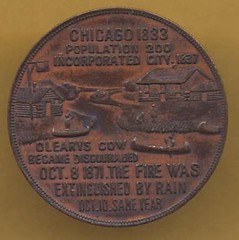
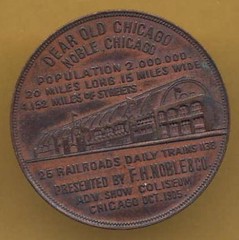
Michael Sanders of Beaverton, OR writes:
I grew up in Chicago and have collected sold medals for many years. I have NEVER seen this piece before an I'm wondering if any of your readers can shed some light on its origin, history and scarcity.
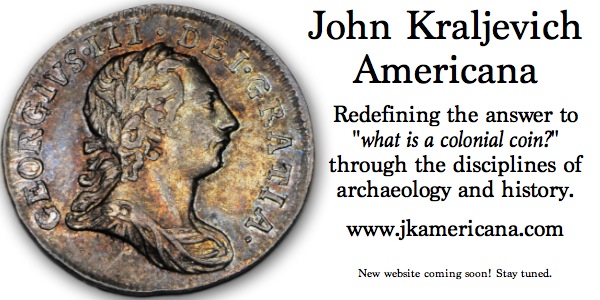
DENNIS TUCKER'S 2013 ANA SUMMER SEMINAR REPORT
Dennis Tucker of Whitman Publishing writes:
Here are some thoughts on the American Numismatic Association Summer Seminar, second session --- a combination of several Facebook postings, and follow-up notes sent to my “Legends in Numismatics” co-teachers (Ken Bressett, Bob Hoge, and Beth Deisher). Our students included published writers, club officers and newsletter editors, vest-pocket dealers, researchers, and three Young Numismatists. I thought E-Sylum readers might be interested in what turned out to be a fun, energetic, and thought-provoking class.
In today's ANA Summer Seminar course (with Robert Hoge, Kenneth Bressett, and Beth Deisher) we focused mainly on writing for numismatic periodicals --- weekly, monthly, and quarterly newspapers, magazines, and journals: the different kinds of publishable numismatic writing; what editors look for; the best way to approach an editor and pitch your article concept; how long an article or column should be. Do numismatic periodicals pay for submissions, and if so, how much? The importance of writing-style guides, like AP and Chicago Manual of Style, and which is preferred by various publications. Legal issues such as libel and copyright. Deadlines. Fact-checking (whose responsibility is it?). Tips on managing a club newsletter or journal.
Our students are great --- smart, talented, and eager to take their writing, editing, and publishing to the next level. They asked sharp, intelligent questions and really picked our brains.
Tomorrow: more of the same! We'll review tonight's homework ("Write a 200- to 300-word query letter to an editor, to pitch your writing concept"). We'll discuss more topics in writing for periodicals. We'll talk about BOOK proposals and start to get into some of the fundamentals of book publishing.
= = =
Wow --- we covered a huge amount of territory in today's ANA Summer Seminar class. First we critiqued and discussed last night's homework (write a 200- to 300-word query letter to an editor, pitching an article idea). We talked about protection and expiration of copyright, how to write and submit a book-manuscript proposal, public domain and "fair use," ways to improve your writing and your creative process, online resources for numismatic writers and researchers, tracking changes in MS Word, using social media, and more. I think we have the best students in the 2013 ANA Summer Seminar!
= = =
In the "Legends in Numismatics" class I taught with Ken Bressett, Bob Hoge, and Beth Deisher at the ANA Summer Seminar, these were some of the students' goals:
- to learn how my writing can improve my coin club
- to learn how to find and develop content for my club newsletter
- to improve my numismatic writing
- to hear the gossip and behind-the-scenes stories that go with the territory in numismatic publishing!
= = =
July 2, 2013: Day 3 of our ANA Summer Seminar course. We covered "How People Collect"; identifying a target audience for your numismatic writing; the possibility of being a proponent of a new segment in the hobby community (e.g., Fred Schwan's pioneering of Military Payment Certificate research and collecting); the traditional arc of a coin collector's development; the difference between long-term collectors and short-term collectors; the average age of coin collectors, according to various sources; "How many coin collectors are there in the United States?"; membership levels of different hobby organizations; the most popularly collected coin series, and how that has changed over the years; non-circulating legal tender (NCLT); learning about, and writing about, world coins; the American audiences targeted by various world mints; readership and membership demographics of coin clubs, and how to run surveys; and the definition of "libel" and why it's important to understand as a writer (including the five factors a plaintiff must prove to successfully claim libel).
Co-teachers Bob Hoge and Ken Bressett played a version of Dr. George French's "Old Cent Whist" (described by William Sheldon in Penny Whimsy), using beautiful ancient coins from their personal collections. We taught the class how a professional copyeditor uses the "Track Changes" function in MS Word. And Beth Deisher recounted a famous Coin World libel case that backfired and led to the downfall of a huge multi-million-dollar scam operator. It was a wonderful day of conversation, knowledge-sharing, and fun!
= = =
July 3, 2013: Day 4 of our ANA Summer Seminar course ("Legends in Numismatics," taught by Beth Deisher, Ken Bressett, Bob Hoge, and myself). We explored club newsletter topic ideas, including the most popular features and sections as identified by David Crenshaw, longtime numismatic newsletter editor-in-chief; Ken and I discussed the "History of the Red Book" (including the early years of Whitman-Hammung and Western Printing Company, R.S. Yeoman, the 10 millionth Red Book, an amusing visit to Whitman by U.S. Mint Director Eva Adams, behind the scenes at the Red Book, errors and misprints, valuable varieties, and more); and Ken discussed the phenomenon of "virtual coin collecting."
We took a short side trip to visit Ken Hopple and his Carson City Mint setup, and to strike our own "Black Diamond" souvenir medals. Then another exclusive highlight of the class: a behind-the-scenes visit to the editorial offices of The Numismatist, where we picked the brains of the magazine's award-winning editors and photographer. (Kudos and thanks to Barbara Gregory, Jerri Raitz, Robert Kelley, and Janine Hall-Conrardy!) We toured the ANA's Dwight N. Manley Numismatic Library, including the Rare Books Room, and reviewed the library's periodicals collection. Another information-packed day of learning and fun for numismatic writers, editors, and researchers.
= = =
July 4, 2013: Day 5 of our ANA Summer Seminar course on writing, editing, research, and collecting. Bob Hoge gave a sterling presentation on famous collectors and collections of the past, going back to ancient times and up to the modern day. We discussed self-publishing (today's print-on-demand technology, as well as yesterday's "vanity press" or subsidy publishing). We looked at the web sites of the Library of Congress and the American Numismatic Society, as case studies in research and image-gathering. We talked about web sites, social media, and promotion of your numismatic writing. And I gave away the ten Whitman Publishing books that we'd looked at throughout the week, including several new releases.
This concluded our formal lessons. That evening: the Summer Seminar's second-session banquet, and presentation of the 2013 Young Numismatist Literary Awards. One of the winners was a student in our class!
= = =
CONGRATULATIONS. . . .
Each year the ANA recognizes young writers through the Young Numismatist Literary Awards, which are funded by Whitman Publishing. Awards are given in three age groups. First-place winners receive a plaque, a $500 cash prize, and a $500 voucher to build a personal library of numismatic books from Whitman Publishing. Second place receives a certificate and a book voucher for... $200, and third place receives a certificate and a $100 book voucher.
Ken Bressett and I presented the 2013 awards at the ANA Summer Seminar banquet last Thursday, July 4th.
The honorees for 2013 include:
Bill Fivaz Young Numismatist Literary Award (Ages 8-12)
First — Garrett Ziss, “Presidents & Their Coins”
Second — Isaac Matittia, “Silver Coinage Usage & Significance: From Ancient Early Times of the Bible to Modern Times”
Third — Benjamin Mous, “The Inspired Collector”
Q. David Bowers Young Numismatist Literary Award (Ages 13-17)
First — Olivia Beauvais, “The Struggle for Recognition: The 1909 VDB Cent”
Second — Danial Usvyat, “On the State of the Modern Cent”
Third — Matt Draiss, “10,000 Tokens: Their Story, Their Variety, Their Fun”
Kenneth E. Bressett Young Numismatist Literary Award (Ages 18-22)
First — Ermin Chow, “Canadian Tire Money as a Numismatic Collectible”
Second — Erik Elbieh, “Making Cents of Circulating U.S. Money”
Third — Luis Ramos, “Inflation in the Roman Empire Due to Incorrect Coinage and Fiscal and Monetary Policies”
CONGRATULATIONS TO ALL OF THESE AWARD-WINNING NUMISMATIC WRITERS!
For more information about ANA programs, see, see: www.money.org
MORE ON INSCRIBED TAXAY BOOKS ON COUNTERFEITS
Last week George Kolbe wrote:
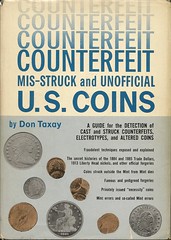 I would like to be contacted by anyone who possesses an inscribed first edition, April 1963 first printing of Don Taxay's "Counterfeit, Mis-Struck, and Unofficial U.S. Coins."
I would like to be contacted by anyone who possesses an inscribed first edition, April 1963 first printing of Don Taxay's "Counterfeit, Mis-Struck, and Unofficial U.S. Coins."
Joel Orosz writes:
George rendered every 2nd printing with a second state dust jacket--like the copy I've been perfectly happy with for more than 30 years--obsolete. Now I need to get a first printing, first d.j. state copy. The hunt is on!
George reports:
Perhaps this will bring a few more JJF-inscribed copies out of the closet. Only one of each variety have been reported thus far.
To read the earlier E-Sylum article, see: QUERY: INSCRIBED TAXAY BOOKS ON COUNTERFEITS SOUGHT (www.coinbooks.org/esylum_v16n28a12.html)
THE BOOK BAZARRE
MORE JOHN J. FORD TOKENS AND MEDALS COMING TO AUCTION
Brian Kendrella writes:
The ANA Sale will include Part XXII of the John J. Ford, Jr. Collection, more than 1,300 lots of tokens and medals, including Early American tokens, Hard Times tokens, Merchant and Trade tokens, Civil War tokens, Territorial tokens, Indian and Post Trader tokens, Transportation tokens, Canadian tokens, Counterstamped coins, Coin Scales and Counterfeit Detectors, and more.
The ANA Sale will also include Part XXIII of the John J. Ford, Jr. Collection with Colonial & Continental Paper Money, Obsolete and Confederate Currency, and United States Fractional Currency.
Both will be online in the next couple of weeks.
The Stack’s Bowers Galleries September 2013 Philadelphia Sale will feature Part XXIV of the John J. Ford, Jr. Collection, predominantly political and campaign tokens and medals.
Dave Bowers writes:
The American Numismatic Association sale will contain over 1,300 lots of John J. Ford's tokens and medals, including Western and territorial tokens, many Feuchtwanger Hard Times Tokens including three-cent pieces, many early American (pre-HTT) tokens including two ORIGINAL Ricketts’ Circus, Sutler tokens, so-called dollars, exposition pieces, award medals, Civil War items, Civil War Tokens, and more. I never knew that JJF had such a treasure trove!
As might be expected, many items come from the F.C.C. Boyd and Wayte Raymond estates, but many other things, indicated in the catalog, came from JJF’s early purchases from before 1953. JJF loved numismatic Americana and, in fact, wrote some articles under this title.
But wait, there’s more! The Stack’s Bowers September 2013 Philadelphia Sale will have Part II of the JJF tokens and medals, and what an event that will be. I haven’t seen the items yet. Added to these will be a landmark selection of Hard Times tokens, including the collection of a major buyer at our memorable Dice-Hicks Collection Sale, many rarities among Civil War tokens, and more. At this early time let me mention that consignment openings are still available—and to get in on the action contact Chris Karstedt via the Stack’s Bowers Galleries website.
It may be worth mentioning that from 1900 to 1910 store cards, Civil War tokens, Hard Times tokens, medals, and the like were the hottest tickets in the marketplace, and hardly anyone collected Morgan dollars, Liberty Seated coins, and other series by mintmarks. Now in the 2nd decade of the 21st century there is a dynamic reawaking of the series, and our recent sales of tokens and medals have created excitement beyond belief!
I will also mention that I have seen an advance copy of my Guide Book of Civil War Tokens, issued by Whitman Publishing LLC, 438 pages, over 1,000 color illustrations, complete pricing by types (Steve Hayden assisted), and more. List $24.95. Whitman’s nationwide distribution has made possible such a low cost; $50 to $75 would be more like it elsewhere! This should be available by the World’s Fair of Money in Chicago in August. If so, I’ll be on hand to autograph copies.
My best to you and your readers.
To view the online auction catalogs (once available), see: http://stacksbowers.com/
THE 1768 ROYAL ACADEMY MEDAL DESIGN SOURCE
Francois Velde writes:
Regarding John Sallay's query, I can point out that the French medal he cites does date from 1717; it is described in this book published in 1724. The motto on the medal: "accipe quae peragenda prius", learn what is first to be accomplished (before reaching the temple), is from Virgil's Aeneid 6:136.
The original design, Minerva showing the temple of glory to young Louis XV, is by Antoine Coypel (1661-1722), and was engraved by Pierre Drevet, although the motto that accompanies the engraving ("tali se dea jactat alumno", the goddess prides herself in such a pupil) was used on another medal commemorating the education of Louis XV.
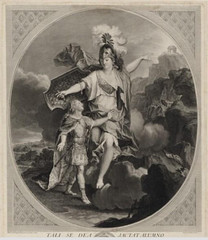

To read the 1717 book, see: Annales de la Monarchie Françoise: M. de Limiers (books.google.com/books?id=Yfu-mXJdiUMC&pg=RA2-PA123)
To view the Pierre Drevet engraving, see: Minerve montrant à Louis XV le temple de la gloire (gallica.bnf.fr/ark:/12148/btv1b8408424b)
To read the earlier E-Sylum article, see: QUERY: 1768 ROYAL ACADEMY MEDAL DESIGN SOURCE SOUGHT (www.coinbooks.org/esylum_v16n28a14.html)
2013 NATIONAL MEDALS OF ARTS AND HUMANITIES
President Barack Obama Wednesday honored luminaries of the arts, including Star Wars creator George Lucas, praising his special effects for freeing movies from "planes in space" with visible strings.
Obama presented National Medals of Arts and National Humanities medals to a group also including musician Herb Alpert, rhythm and blues legend Allen Toussaint, author Joan Didion and sportswriter Frank DeFord.
"The arts and the humanities aren't just a source of entertainment, they challenge us to think and to question and to discover, to seek that inward significance -- and that helps us grow and to change and to reach new heights," Obama said at a White House ceremony.
The president went off script when he came to pay tribute to Lucas, praising him for making "it look like those planes in space are actually flying."
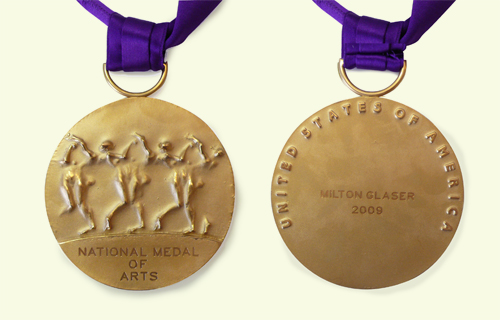
Those receiving the Medal of Arts included Alpert, philanthropist Lin Arison, dancer Joan Myers Brown, singer Renee Fleming, author Ernest Gaines, painter Ellsworth Kelly, scriptwriter Tony Kushner, Lucas, comedian Elaine May, architect Laurie Olin, Toussaint and the Washington Performing Arts Society.
National Humanities Medal recipients were author Edward Ayers, economist William Bowen, historians Jill Ker Conway and Natalie Zemon Davis, Deford, Didion, political scientist Robert Putnam, writer Marilynne Robinson, poet Kay Ryan, book critic Robert Silvers, actress Anna Deavere Smith and writer-photographer Camilo José Vergara.
To read the complete article, see: May the Medal be with you: Obama honors Lucas (uk.news.yahoo.com/may-medal-obama-honors-lucas-194918222.html#eF6tpAB)

ARGENTINE EVITA 100-PESO NOTES ARE LEGAL TENDER
 Argentina's central bank has warned businesses to stop rejecting commemorative bank notes bearing the image of Eva Peron to mark the 60th anniversary of the iconic former first lady's death. President Cristina Fernandez, whose fiery speaking style often prompts comparisons with that of “Evita” unveiled the 100-peso bills emblazoned with her profile a year ago.
Argentina's central bank has warned businesses to stop rejecting commemorative bank notes bearing the image of Eva Peron to mark the 60th anniversary of the iconic former first lady's death. President Cristina Fernandez, whose fiery speaking style often prompts comparisons with that of “Evita” unveiled the 100-peso bills emblazoned with her profile a year ago.
But publicity surrounding the newly-minted notes was not wide enough to overcome doubts from small businesses where cashiers have rejected the bills for being unfamiliar and with printing errors. So the central bank this week launched a hotline for people to report those who refuse to accept the bills, threatening to fine those who keep turning them away.
“The 100-peso bills with the image of Maria Eva Duarte de Peron are legal tender and must be accepted by all retailers and financial institutions,” the central bank said in a statement this week.
Each is worth about 18.5 US dollars according to the official exchange rate. Even if the bills are not widely accepted, Evita's image is very much alive in Argentina's political life six decades after she died of cancer at the age of 33.
To read the complete article, see: “Evita” 100-Peso bill are legal tender and must be accepted, warns Argentine central bank (en.mercopress.com/2013/07/10/evita-100-peso-bill-are-legal-tender-and-must-be-accepted-warns-argentine-central-bank)
THE BOOK BAZARRE
A 3D PRINTED BOOK OF TEXTURES AND RELIEFS
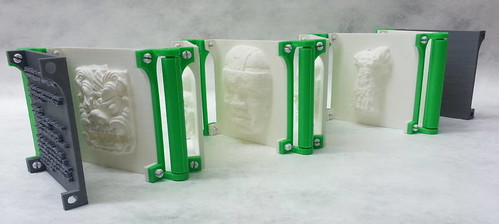
This is my first iteration of a 3D printed book. I have been thinking for some time how it would be nice to produce a book of textures and reliefs. To publish and distribute all the wonderful architectural patterning and decoration we enjoy here in Chicago and beyond.
The impetus for this project was a call for submissions from the Center for Book and Paper here in Chicago at Columbia College. The exhibition calls for both "print on demand" and "photographic" books. This "publication" is my response.
The subject matter for this book is derived from 3D scans made of sculptures and reliefs, found at The Art Institute of Chicago and The Metropolitan Museum of Art in New York. The scans were all produced using a regular DSLR camera and a software package called 123D Catch. By taking multiple digital photographs of a subject, the user is able to create a lifelike 3D scan of an object, person or architectural feature."
Tom's book is available as a free, downloadable shapefile on Thingiverse.
To read Cory Doctorow's Boing Boing article, see 3D printed book of textures and reliefs (boingboing.net/2013/07/11/3d-printed-book-of-textures-an.html)
To read the complete article, see: Orihon (Accordion Book) (www.thingiverse.com/thing:110411)
ULTRA HIGH RELIEF GREAT PYRAMIDS COIN
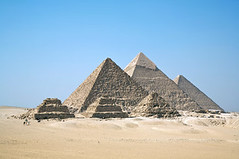 Egypt’s Great Pyramids are one of the world’s most beautiful and awe-inspiring sights and an amazing and technically unique coin issue on behalf of the British Virgin Islands brings these amazing structures to life.
Egypt’s Great Pyramids are one of the world’s most beautiful and awe-inspiring sights and an amazing and technically unique coin issue on behalf of the British Virgin Islands brings these amazing structures to life.
The Great Pyramid at Giza has stood at the end of the desert, to the west of the River Nile, since the 26th Century BC, when it was built for Pharaoh Khufu (Cheops). Two later kings of the 4th Dynasty – Khafre (Chefron) and Menkaure (Mycerinus) – built pyramids of their own close by and together these three monuments form one of the world’s most familiar group of structures. The Great Pyramid stands 137m/450ft high and is constructed of more than 2.25 million blocks of limestone which weigh more than 2.5 tonnes each.

As a tribute to these amazing structures, this stunning new coin has been issued in ultra high relief with the highest point of this amazing coin standing at approximately 4.5mm to 5mm above the main face of the coin. When viewed from the side, the true genius of the coin comes to life, featuring not just the three-dimensional pyramids, but also the flowing sand dunes at Giza that create the irregular desert landscape. In addition, sand brought back by Pobjoy Mint’s Managing Director, Taya Pobjoy, from the site of the Great Pyramids has been encapsulated into the coin making this one of the most unique coins in the world.
Available in 1oz Fine Silver, the obverse of the coin carries an effigy of Her Majesty Queen Elizabeth II by Ian Rank-Broadley FRBS. Each precious metal coin has been struck to the highest quality and each coin has been beautifully handcrafted to give this final stunning effect. The coin is presented in a gold coloured triangular box in keeping with the coin.
To read the complete article, see: Coin celebrating the great Pyramids at Giza (www.coinsweekly.com/en/News/4?&id=2110)
FEATURED WEB PAGE: GLASGOW SQUARE COMMUNION TOKENS
This week's Featured Web Page is from Mike Shutty's Communion Tokens blog.CTs do not have to be expensive to have great stories. Here is one that is part of a fascinating series that will keep you searching.
Let me introduce you to a CT from Glasgow -- one of my favorites -- that is frequently available in the marketplace for about $20 to $50. This token is a single-sided square with a pair of concentric circles in the center, forming a band, with the legend: GLASGOW 1819. It is a beautiful piece, as it depicts the city crest in full detail with a full complement of ornaments.
This token is part of a series of CTs used in Glasgow, all with the same design and crest. They were produced in 1714, 1716, 1725, 1776 and 1819. It is difficult to tell which church used these particular CTs, as there were several parishes located within the royal burgh. It is likely, but not confirmed, that these CTs were used at the same parish.
In addition to being part of a short series, this CT represents a specific style of token design. The hallmark of this style includes two concentric circles, centered, that forms a band within which a legend is placed. This style became popular across the western midlands in the latter half of the 1700s. In fact, the use of this design peaked in the 1770s and remained popular until a sharp decline after 1832. Sixty percent of them come from Lanark and Ayr in that order. Another 25% of them come from Argyll, Stirling and Renfren. One or two reached east to Angus, Kirkcudbright and Aberdeen. With such a tight geographic distribution, it is not surprising that the style is referred to as the Glasgow square.

communiontokens.blogspot.com/2013/07/
common-tokens-can-be-great-glasgow.html
